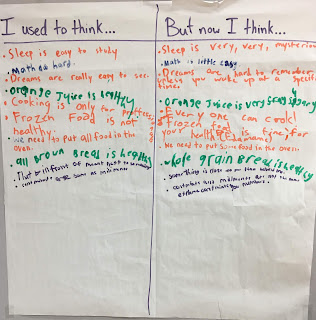Construct the knowledge and make the thinking visible
The
most effective teaching practices and learning environments challenge learners’
thinking beyond what they could achieve independently. The role of the teacher
is to support student learning in what Vygotsky (1978) described as the ‘zone
of proximal development’.
Understanding
cannot be transmitted from one person to another; it is always constructed in
learners mind. In order to develop the learner’s understanding, their existing
knowledge must be challenged and extended.
We
do not generally hear other people thinking; just see the result of their
thinking as an idea or an opinion. As teachers, how can we develop a culture of
thinking? Students are natural learners and thinkers. It is important to nurture
thinking in the daily lives of learners and to make it visible. Culture of
thinking can build a strong learning community. Teachers have to provide an
environment to support deeper thinking and engage students in learning.
As
teachers, we are interested in both students’ learning and understanding,
therefore, we have two main goals: creating opportunities for thinking and
making students’ thinking visible. Quality of education is also about the development
of habits of mind and thinking dispositions. Making students thinking visible
becomes an on-going component of effective teaching.
Thinking
routines are designed to enrich classroom learning in the content areas and
developing learners’ thinking and ability. Visible thinking includes a number
of ways of making students’ thinking visible to themselves, to their peers, and
to their teachers. When thinking is visible in classrooms students are in a
position to think about their learning.
Routines
helped me managed student behaviour, and interactions to organise their work of
learning and to establish rules for communication. Routines are designed to
give students thinking structures such as using techniques to explore ideas, synthesise
and organise ideas, and dig deeper into the ideas. This year I am working with
learners who are introverted, anxious, and hesitant to express their feelings.
Visible thinking routines gave them roadmap to engage in discussions and
activities in the classroom, provide feedback to each other, and develop
students’ social and emotional learning.
I decided to share with you the routines that
I found useful. I used “What makes you
say that?” routines for the inquiry line of “roles and responsibilities in a
team” for a long-term project. This
routine develops the habit of backing up one’s opinions and ideas with
evidence. Students had two field trips to the school cafeteria and the fire
station. This opportunity let them think how the kitchen crew and fire fighters
work together and how they are aware of their roles and responsibilities in the
team.
This
routine helped me ask learners to share their interpretations backed with
pieces of evidence so that; others have an opportunity to consider multiple
viewpoints. It is important to follow up asking the key question “What makes
you say that? “of this routine.
Students
searched about Kitchen crew. They identified and came up with a list of
required roles in a kitchen crew such as pastry chef, soup chef, roast chef and
they have they realised each member has own roles and responsibilities in
a team.
Students
understand that someone takes care of fire safety in protecting and serving the
community. They are fire fighters. Although it was their first acquaintance
with the fire fighter team they were excited about their roles and
responsibilities. They witnessed a demo fire to observe how they work as a
team. Fire fighters demonstrated how they receive phone calls, take care of
injured people and assign their seats in the vehicle. The Engineer showed how
he pumps the vehicle to give water to fire fighters. Students met with Captain
to learn the role of the leader. Because students developed a scheme for
thinking about the roles in a team before they witnessed teams in action, they
were able to strengthen foundations by connecting the concepts with real world
examples.
This routine gave me a chance to make
interchanges between my students and I so while documenting my students’
thinking it is an option to create an opportunity to share what they observed
and make their thinking visible.
“Question
Start routines” helped me ask students to develop deep and interesting
questions that provoke thinking and inquiry into a topic. It happened in the
inquiry cycle of “Going further”.
Students presented another prospective of topic.
I
have experienced the other Visible Thinking routines such as, “Think, Puzzle,
Explore”, “See, Think, Wonder”, “Think, Pair, Share”, “Colour, Symbol, Image”
etc.
When
the teacher focuses on making thinking valued and visible in classrooms the
questioning shifts away from asking knowledge based questions to asking more
constructive questions. Children are not born with knowledge. A child must
construct his or her own form of knowledge. Visible thinking routines create
the structure to build strong and lasting knowledge.
By:Parvana Guliyeva
PYP Teacher
UCSI International School
Recourses:




Comments
Post a Comment